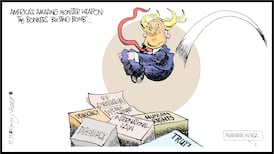The announcement by the IRA on Thursday night that it was re-engaging with the de Chastelain commission was not unexpected. From late last week, republican and security sources were aware of the pressure the republican movement was coming under in the aftermath of the Islamic attacks in the US.
The "war" that has been declared by the US is primarily against "international terrorism". The IRA, and to a lesser extent the "Real IRA", fit into this category. The IRA has well-established links with international terrorist groups, including those involved in the narcotics trade in Central America, the Basque group ETA and a number of groups in the Middle East.
It is now believed the IRA has had links with FARC in Colombia since 1988. Exchange of technical information between the IRA's "engineering department" and FARC led to the spread of the heavy "barrack buster" mortar to Colombia in the mid-1990s.
An instance of the use of the weapon emerged this week during an Irish Times interview with the North's Oversight Commissioner for Policing, Mr Tom Constantine. Mr Constantine was director of the US Drug Enforcement Agency (DEA) for five years during the Clinton administration and developed close links with the Colombian National Police. Between 1994 and 1995, with US support, the problem of corruption in the National Police was tackled and over 9,000 police were sacked.
Colombia was producing most of the heroin coming into the US, so it was clearly an area of vital interest to the DEA.
In 1998 Mr Constantine, as head of the DEA, visited an anti-narcotics base in the Colombian countryside run by the National Police that had been attacked by the FARC guerrillas. FARC used heavy mortars identical to those perfected by the IRA. They then overran the barracks and kidnapped 150 anti-narcotics police. More than 50 officers were injured.
Last week, Colombia newspapers reported that at least 12 IRA members have visited Colombia since 1998. The Irish Times understands that links between the IRA and FARC date as far back as 1988.
It was concern over links such as these that led the US special envoy, Ambassador Richard Haass, to confront Sinn FΘin over the issue of the arrests of three Irish republicans in Colombia.
Mr Haass later said: "They were not there for their vacations; they were not there for an exchange of views on negotiation techniques in the peace process, but for discussions with FARC on matters that come under the rubric of terrorism."
The IRA statement of Thursday night said its governing army council had not sanctioned any visits to Colombia. However, the IRA used the same excuse when its members shot dead Det Garda Jerry McCabe in Limerick in May 1996; when it was found to be smuggling weapons from Florida in the summer of 1999; and when it shot dead one of its own members, Charles Bennett, in north Belfast on July 25th, 1999.
Senior Garda sources have indicated that the links between the IRA and FARC are sanctioned by the operational leadership. This section of the leadership is called the "general headquarters staff" so, while it may be theoretically correct to say the army council did not sanction such operations, it did know about them.
Further problems in the relationship between Sinn FΘin and the US administration arose in the immediate aftermath of the suicide attacks. Last weekend, Sinn FΘin sent a delegation to "show solidarity" with the prisoners on hunger strike in Turkey.
The Sinn Fein delegation, led by the MLA Mr Alex Maskey was arrested at Istanbul Airport. The visit also came shortly after a suicide-bomb attack in Istanbul that killed an Australian tourist. Turkish police, on a state of alert for other attacks, were suspicious of the reason for the visit by the Irish republicans and held them for a short time before releasing them. Sinn FΘin appears to have missed the point that Turkey is one of the US's most important allies in eastern Europe and south-west Asia.
In the past 10 days, global politics altered as a result of the assault on the US. That the IRA is not immune to this is demonstrated in its statement of Thursday night signalling its move towards decommissioning.
Republican sources pointed out that where pressure from previous US administrations and the British and Irish governments had failed completely to budge the IRA on decommissioning, the events in New York and Washington on September 11th created a new dispensation.
One source pointed out that the real threat the IRA has been able to hold over its political opponents is that it will return to war and attack commercial and financial targets in London. It did this in May 1992 when it bombed the Baltic Exchange, killing three people including a 15-year-old girl, Danielle Carter; and again in February 1996 when it bombed Canary Wharf at the end of its first ceasefire. The source said there is "no way" the IRA could countenance carrying out such an act against the US's closest ally ever again.
Jim Cusack is Security Editor of The Irish Times









